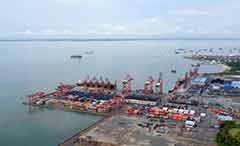China’s Q1 trade buoyant, surplus shrinks
2017-04-14
Xinhua
BEIJING — Boosted by a pickup in external demand and a stable domestic economy, China’s foreign trade retained robust growth in the first quarter with a shrinking surplus, customs data showed on April 13.
Imports grew faster than exports in the three months with surging import prices, resulting in a 35.7-percent shrinking of the trade surplus, data from the General Administration of Customs (GAC) showed.
Exports in yuan-denominated terms rose 14.8 percent year on year in the first quarter, while imports increased 31.1 percent.
Foreign trade volume reached 6.2 trillion yuan (about $902.47 billion) in the first quarter, up 21.8 percent year on year, with a surplus of 454.94 billion yuan.
Surging import prices and a stable domestic economy boosted the figures, GAC spokesman Huang Songping told a press briefing on April 13.
“The foreign trade situation in China is still complex with many instabilities and uncertainties, and the difficulties that China faces are not short-term ones,” Huang said, adding that foreign trade expansion is likely to fall back in the second quarter.
During the first three months, trade with the European Union gained 16.9 percent year on year, while that with the United States and ASEAN increased 21.3 percent and 25 percent, respectively, together accounting for 41.4 percent of foreign trade.
Trade with some countries along the Belt and Road has registered growth. In the first quarter, China’s trade with Russia, Pakistan, Poland, Kazakhstan and India rose by 37 percent, 18.7 percent, 19 percent, 69.3 percent and 27.7 percent respectively.
A weaker yuan, stronger global demand, and diminished threat of US tariffs contributed to China’s strong exports in Q1, said Bloomberg chief Asia economist Tom Orlik.
A marked contraction in China’s trade surplus with the world should take the edge off complaints from trade partners, he said.
The Q1 export growth hit a two-year high largely backed by economic recovery in the United States, the European Union and Japan, said Deng Haiqing, chief economist with JZ Securities, who also cited a relatively weak yuan in fueling the growth.
Meanwhile, strong momentum of domestic industrial enterprises along with a remarkably warmer real economy contributed to the surge in imports, he said.
The country’s manufacturing purchasing managers’ index (PMI) came in at 51.8 in March, staying in expansion territory for an eighth consecutive month.
The reading beat market expectations and was the highest in nearly five years. A PMI reading above 50 indicates expansion.
The Baltic Dry Index (BDI), a barometer of international trade, rose to 1,141 points last month from 759 points in February, according to Ren Zeping, chief economist at Founder Securities. An increase in BDI means growing global demand for raw materials and more need for shipping services.
Import figures in 2017 will be better than last year as domestic demand continues to recover, while an all-out trade war between China and the United States has become unlikely, further boosting the outlook of foreign trade, he said.
The biggest risk remains US trade policy, but the chance of sweeping trade sanctions has come down, said Orlik in a research note.
A 100-day review of the bilateral trade relationship — announced by the White House — will likely result in some increase in trade measures, he added.
Customs data also reflected the improved structure of trade. In the first quarter, the volume of general trade grew 23.2 percent to 3.49 trillion yuan, taking up 56.2 percent of the total volume of foreign trade, 0.6 percentage points higher than the same period last year.
Private enterprises took a larger share of foreign trade. Trade of private enterprises grew 22.5 percent to 2.28 trillion yuan, accounting for 36.8 percent of the country’s total foreign trade volume, 0.2 percentage points higher than the same period last year.
In a breakdown of products, electro-mechanical products and traditional labor-intensive products remained the major export goods.
Meanwhile, imports of primary commodities such as iron ore and crude oil continued to grow in both volume and price.

